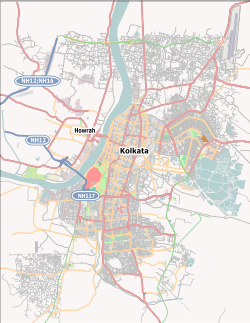Fort William (India)
| Fort William | |
|---|---|
| Kolkata, India | |

Fort William, a view from the inside, c. 1828
|
|
| Coordinates | 22°33′28″N 88°20′17″E / 22.5577°N 88.3380°E |
| Type | Fortress, garrisoned and armoured Army Headquarters. |
| Site information | |
| Controlled by |
British East India Company Siraj Ud Daulah Indian Army (Current) |
| Site history | |
| Built | 1781 |
| In use | 1781 - present |
| Battles/wars | Battle of Plassey |
| Garrison information | |
| Garrison | Eastern Command |
Fort William is a fort built in Calcutta (presently Kolkata) on the eastern banks of the River Hooghly, the major distributary of the River Ganges, during the early years of the Bengal Presidency of British India. It was named after King William III of England and Ireland and II of Scotland. In front of the Fort is the Maidan, which used to be a part of the Fort and is the largest urban park in Calcutta.
There are two Fort Williams. The original was built in 1696 by the British East India Company under the supervision of John Goldsborough. Sir Charles Eyre started construction near the bank of the River Hooghly with the South-East Bastion and the adjacent walls. It was named after King William III in 1700. John Beard, his successor, added the North-East Bastion in 1701, and in 1702 started the construction of the Government House (Factory) at the centre of the fort. Construction ended in 1706. The original building had two stories and projecting wings. An internal guard room became the Black Hole of Calcutta.
In 1756, the Nawab of Bengal, Siraj Ud Daulah, attacked the Fort, temporarily conquered the city, and changed its name to Alinagar. This led the British to build a new fort in the Maidan.
The rebuilding of the fort was started by Robert Clive in 1758, after the Battle of Plassey (1757), and completed in 1781 at a cost of approximately two million pounds. The area around the Fort was cleared, and the Maidan became "the Lungs of Kolkata". It stretches for around 3 km in the north-south direction and is around 1 km wide. Fort William is one of Kolkata's most enduring Raj era edifice. This is a fort of stupendous dimensions and is spread over an area of 70.9 hectares. It was built by Robert Clive in the year 1781.
...
Wikipedia

